Bromham Church Alterations and Repairs
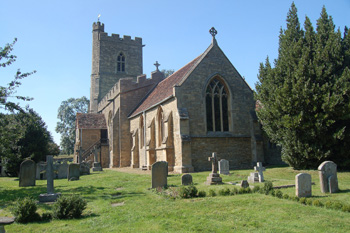
Bromham church from the east August 2007
Some of the structural history of the church can be found in detail in Bedfordshire Historical Record Society Volume number 73 of 1994 Bedfordshire Churches in the Nineteenth Century: Part I: Parishes A to G, put together by former County Archivist Chris Pickford from numerous sources some held by Bedfordshire & Luton Archives & Records Service and some held elsewhere or published.
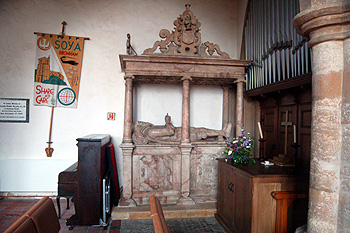
Monument to Sir Lewis Dyve at the east end of the north aisle May 2012
The earliest known change in the church after the Middle Ages was the appropriation of the hundred year old brass of Thomas Wideville and his two wives by Sir John Dyve in 1535. The first new addition we know of is the monument to Sir Lewis Dyve who died in 1603. This stands at the east end of the north aisle. A lecture on the history of Bromham by Canon Browning, the vicar, was reported in a local newspaper towards the end of the First World War (the cutting has no date). The cutting includes the following curious story: "Speaking of the boots and sword worn by Sir Lewis Dyve and still preserved at the hall, Canon Browning related that a Bedford lady had told him that some years ago she and a friend walked over to the church, and while kneeling therein they heard the heavy tread of booted feet and the trailing of a sword on the pavement, passing along the aisle, but they were unable to see anybody. In these days many people thought it possible to receive these informations from those who had gone before, and who should say that the uneasy spirit of Sir Lewis Dyve (who died in Somerset) was not yearning after his ancestral home and the church in which he had worshipped ... In the course of the discussion Mr. Henman [Honorary Secretary of the Bedford Natural History and Archaeological Society] confirmed the ghost story from his own experience, and said that on one occasion when he was taking a rubbing of a brass in the church he thought he heard someone enter by the north door and pass along the north aisle towards the vestry, but on looking up saw no one, and on going to vestry he found no one there; this occurred some months before he heard of the ghost story at all of of the Bedford ladies' experience. Certainly the footsteps were not heavy but light". Perhaps and perhaps not. If there are such things as ghosts it might be more likely to be the Sir Lewis Dyve whose monument lies in the north aisle rather than his more famous Royalist descendant.
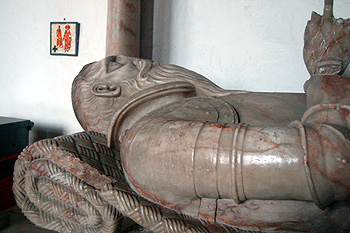
Close up of the monument to Sir Lewis Dyve May 2012
It is carved from alabaster and has his effigy lying on the chest, his head on a rolled up mat. There had been a long standing disagreement with the Boteler family in nearby Biddenham in which, so far as we can tell, Sir Lewis was the aggressor.
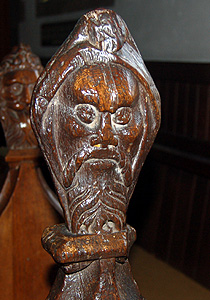
An original bench end in the chancel May 2012
The alms box and its stand at the north-west side of the nave date from the 17th century. So too, probably, do the original bench ends on the south side of the chancel which were copied by William Butterworth when he rebuilt this part of the church in 1868.
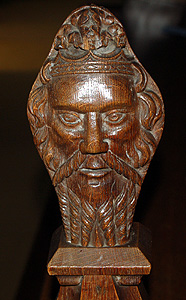
A Butterworth bench end in the chancel May 2012
A sounding board above the pulpit (now removed) was dated to 1630 by William Marsh Harvey in his book of the 1870s The History and Antiquities of the Hundred of Willey.
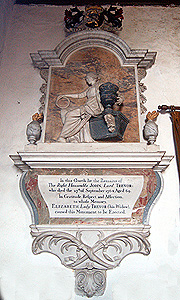
Memorial to the 3rd Baron Trevor May 2012
In 1727 a painting of the Royal Arms was purchased for £5 [P67/5/1]. Two monuments date to the 18th century – that to the 1st Baron Trevor who died in 1730, which was moved into the Dynevor Chapel in 1868 and that to the 3rd Baron Trevor who died in 1764 on the north wall of the north aisle.
In 1740 the 2nd Lord Trevor established a lending library in a room above the south porch. The room, like that above the north porch, is reached by an external staircase. The plaque outside states:
THIS SMALL LIBRARY WAS
FOUNDED & FREELY GIVEN
FOR THE USE OF THE MINISTER
& THE PARISH OF BROMHAM
BY THOMAS LORD TREVOR
IN THE YEAR 1740
NO BOOK TO BE TAKEN OUT
WITHOUT LEAVE OF THE
MINISTER OR LORD OF
THE MANNOR
A full annotated catalogue of the library was produced by E. C. Cooper of Bromham in 1959 (a copy is kept in the Bedfordshire Archives Searchroom pamphlets 130BRO). It comprised 860 books. The library was housed here until it was removed in 1984. In June 2008 the parish entered a 30 year loan agreement with The National Trust and since 2009 the books have been on display (along with other National Trust owned books) in the Book Room at Canons Ashby house in Northamptonshire. .
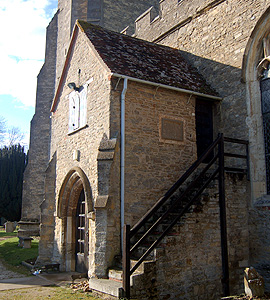
The south porch March 2012
A new west gallery, by William Tucker was installed in 1810. [P67/5/1]. In cost £12/12/- The Northampton Mercury of 7th September 1816 noted: "On Wednesday last [4th September], much damage was done to the Church at Bromham, near Bedford, by the lightning, which was uncommonly vivid; a number of large stones were forced from the tower to a considerable distance, and the pews were very much injured by the fluid". A carpenter, a mason and a glazier together charged £207/17/6 to repair the damage [P67/5/1]. This was a considerable sum. One wonders if the gargoyles on the north-east, south-west and south-east corners of the tower received their damage at this time, particularly the gargoyle on the south-east corner of which barely anything survives. If so, the decision may have been taken to leave them as they were given the great expense of the other repair work.

Carving on the north-west corner of the tower May 2012
An attractive memorial stands in the Dynevor Chapel. It is to thirteen years old Eva Gwenlian Rice Trevor who died in 1842. She floats up to Heaven in a cloud. It presumably stood elsewhere until the chapel was built in1868.
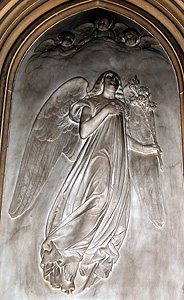
Close up of the memorial to Eva Gwenlian Rice Trevor May 2012
William Marsh Harvey stated that a further £100 was spent on repairs to the church in 1844. In June 1847 John Martin, librarian of Woburn Abbey visited the church. He wrote a series of descriptions of Bedfordshire churches for the Northampton Mercury in the middle of the 19th century under the pseudonym WA. His pieces are usually hugely opinionated and waspish. His account of Bromham is below:
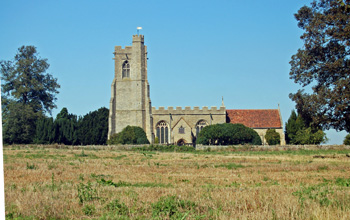
Bromham church from the south August 2007
“The entrance into this church was rendered more agreeable than usual by the evident attention to propriety and good order that prevailed”.

The interior looking east May 2012
“The chancel-roof is ceiled, and the glare produced by the repeated coats of plaster highly disagreeable. The altar-table was of better character than many recently noticed. Why this spot is selected for suspending the tables of kindred we cannot imagine; they interfere with the sacred quarter. Let those who wish to study them do so in the porch if they must be suspended at all. Part of the column of the chancel-arch has been mutilated to make room for sittings, which, however, are not enclosed. We grieved to see common iron railings surrounding a monument [presumably the one to the 1st Baron Trevor moved into the Dynevor Chapel in 1868]. This material should never be admitted within a church, and placed in a quarter where every secular appearance should be banished, where all should breathe quiet and repose.
“Let us depart where shadows cease,
With words of blessing and of peace,” –
“is most repulsive. The flooring around the holy table is of common matting, and where there are no monumental slabs, the rest is paved with ordinary tiles”.
![The interior before restoration [X535/3]](/CommunityHistories/Bromham/Bromhamimages/The interior before restoration [X535-3].jpg)
The interior before restoration [X535/3]
“The nave has a wooden roof, but whitewash is displayed on the columns and walls. The western window is shut out by boarding, and an ugly singing gallery, we suppose it is intended for. Independent of their deformity, galleries are too frequently the cause of a very irreverent practice, which we have observed in several country churches, namely, when the singing commences the congregation wheel round, turn their back on the altar and minister, and appear to be singing to the singers instead of the glory of God. The sittings are for the most part open; but there is one large square pew, with a door in the wall to admit the occupants; the good tastes and feeling of those who have done so much for the church and the village will, we trust, banish this ugly affair. Few will ere long defend such selfish appropriation. In the aisle is a fine monument, the hero of which [presumably Sir Lewis Dyve] is sadly interfered with by a large square box – these square pews prevail here”.
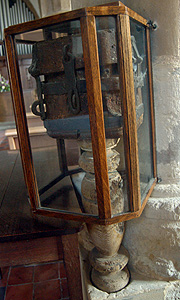
The alms box May 2012
“The pulpit, reading desk, and clerk’s pew are all huddled together in the usual unsightly manner; there is, in addition, a sounding board. In a properly built church, and a good open roof, this is quite useless. A portion of the screen remains. We were glad to see the alms box, and hope this natural appendage to our church furniture will be restored universally. It affords the visitor the opportunity of dropping in his humble contribution, and might be made the lowly commencement of aiding the restoration of some decoration of which the building stood in need. Various designs for them have been seen in the ‘Instrumenta Ecclesiastica’, or the Glossary of Architecture; and as appropriate specimens may be procured for a very moderate sum, expense cannot be urged for not replacing them. The font has its drain and leaden lining, but it is not used. The roof of the porch has not escaped ceiling; this practice is, we fear, the result of churchwarden ignorance and jobbery. There is a school and a lending library, the latter kept over the porch. We are sorry to add that here one of our wealthy colleges [Eton] afford another example of their little attention to the wants of the church; there is but one service, the cause of which is, we presume, the narrow stipend compelling the incumbent to take other duty to eke out his income. When these deficiencies are remedied, then with more propriety may it be said, “Floreat Etona””.

The Dynevor memorial window May 2012
The “ugly singing gallery” was removed 1868 [P67/5/1]. In the same year Lord of the Manor, George Rice Trevor, 4th Baron Dynevor (1875-1869) obtained a faculty for a family vault in the churchyard [DSA2/1/153]. The vault lay under the north side of the chancel and extended out into the churchyard. In 1868 a chapel, called the Dynevor Chapel was built over the vault and the monuments to the 1st Baron Trevor and Eva Gwenlian Rice Trevor were moved inside.
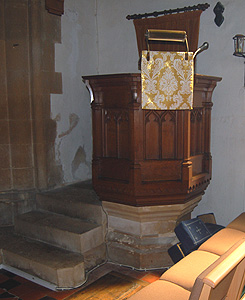
The pulpit May 2012
The Dynevor Chapel was part of the restoration of which “the building stood in need” as noted by John Martin. The architect who carried it out was William Butterfield and it took two years, 1868-1869. He completely rebuilt the chancel and added a vestry [P67/2/1-3]. A new pulpit and font cover were made by Rattee and Kett of Cambridge and a new lectern by Lavers & Barraud.
![The church following the fire of 1906 [Z49/415]](/CommunityHistories/Bromham/Bromhamimages/Z49-415 after the fire of 1906_350x222.jpg)
The church following the fire of 1906 [Z49/415]
On 11th September 1906 a fire badly damaged the tower and the west end of the nave. It destroyed the bells which had only been re-hung three years before. During repairs the organ chamber was enlarged by enclosing the space between the Dynevor Chapel and the north aisle and a new organ was installed.
![The interior looking east in 1908 [Z474/35]](/CommunityHistories/Bromham/Bromhamimages/Z474-35 church interior 1908_349x251.jpg)
The interior looking east in 1908 [Z474/35]
Electricity was laid on to the church in 1927 [P67/2/13]. The vestry roof was repaired in 1939 [P67/2/10] but by 1952 more repairs were needed [P67/2/14, 17-18]. A new heating system was installed in 1964 [P67/2/21] replacing the 19th century tortoise stoves. The church was rewired in the late 1970s [P67/2/24]. Mains water was not installed until the early 1980s [P67/2/26] and stonework repairs were carried out at the same time [P67/2/26-28].
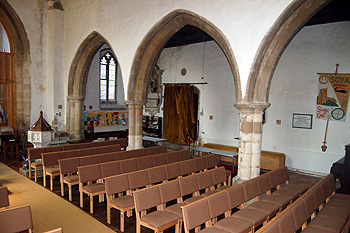
The view from the pulpit into the north aisle May 2012
In 2015 planning permission was granted for alterations to the south porch and for an extension to the north side of the church. The south porch was altered to replace the steps with a slope from the outside directly into the church to enable wheeled access. The south door was enlarged to fit the new doorway. The extension to the north side (comprising toilets, kitchen and a large meeting room) was formally opened by the Bishop of Bedford in a service of dedication on 26th September 2021.